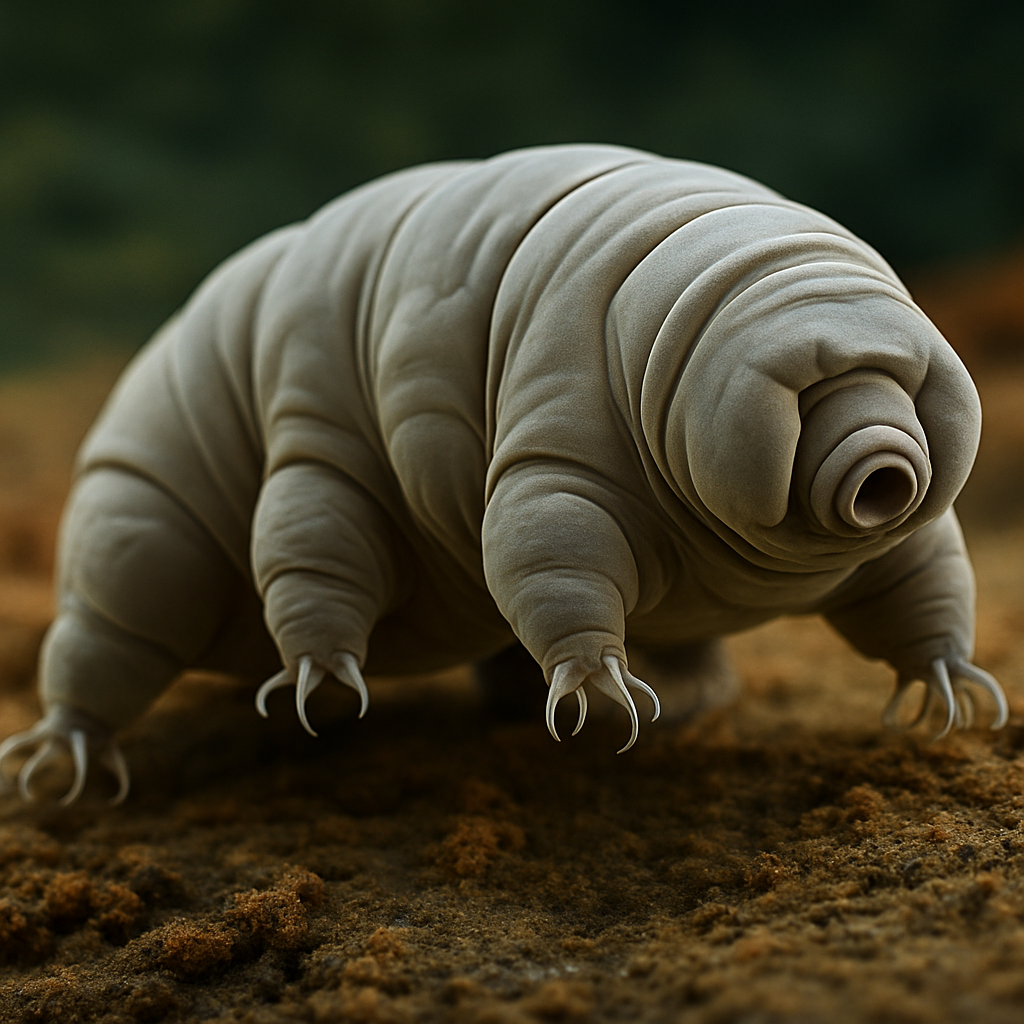The Tardigrade: A Remarkable Water Bear
Tardigrades, commonly known as water bears, are microscopic creatures that have fascinated scientists and the public alike for centuries. Despite their small size, tardigrades have earned a place in the scientific community as some of the most resilient and intriguing organisms on the planet. Their ability to survive extreme environments that would be lethal to most other forms of life has earned them the title of “extremophiles.” From the icy polar regions to the boiling depths of the ocean, tardigrades can thrive in a variety of extreme conditions, making them a symbol of life’s resilience and potential for survival in the harshest environments.

Discovery and History
Tardigrades were first discovered in 1773 by German zoologist Johann August Ephraim Goeze. He observed them in a drop of water from a moss plant and initially referred to them as “little water bears” due to their unique, bear-like appearance. In 1787, the renowned English scientist Thomas Huxley gave them the name Tardigrada, which is derived from the Latin words “tardus” (slow) and “gradus” (step), referencing their slow, lumbering movement.
Although tardigrades are microscopic, they were one of the first animals to be studied under a microscope. Over the centuries, scientists have discovered more about their incredible biology, leading to a deeper understanding of their resilience and capabilities. Today, tardigrades are found in nearly every environment on Earth, from the depths of the oceans to the highest mountains.
Physical Characteristics
Tardigrades are incredibly small, measuring between 0.3 and 0.5 millimeters in length. Their bodies have an unsegmented, oval shape and are covered in a tough, translucent cuticle. One of their most distinctive features is the presence of four pairs of legs, each ending in small claws. These legs are used for locomotion, and although their movement is slow and somewhat awkward, tardigrades can crawl, walk, and even swim.
The head of a tardigrade is often shaped somewhat like a bear’s head, with a pair of simple eyes (in some species), and a specialized mouthpart called a stylet. The stylet is a needle-like structure that allows tardigrades to pierce plant cells, algae, or other microscopic organisms to feed. Tardigrades are primarily herbivorous or detritivorous, feeding on plant cells, bacteria, and other microorganisms.
One of the key aspects of their physiology is the presence of a cryptobiotic state. This state is the key to their survival in extreme conditions, which we will explore later. But it’s important to note that tardigrades are relatively simple organisms with only about 1,000 cells in their body, compared to the millions of cells found in more complex animals.
Reproduction and Lifespan
Tardigrades are capable of both sexual and asexual reproduction, depending on the species. In many species, males and females engage in mating, with the female laying eggs. The eggs are often laid in protective coverings that are resilient to environmental stress. In some species, the eggs can remain dormant for years, waiting for the right conditions to hatch.
Interestingly, some tardigrades can reproduce asexually through a process known as parthenogenesis, where females produce offspring without the need for male fertilization. This method of reproduction is typically seen in isolated populations and can help maintain genetic diversity in certain conditions.
The lifespan of a tardigrade is quite variable, depending on environmental factors. In favorable conditions, tardigrades can live for several months. However, they can also remain dormant in a cryptobiotic state for much longer periods when conditions are not ideal. Some species have been known to survive for several years in a dormant state.
Resilience and Extremophiles
Tardigrades are among the most resilient creatures on Earth, capable of surviving in extreme conditions that would be lethal to most other life forms. One of their most remarkable abilities is their capacity to survive without water for extended periods.
In times of drought or other environmental stress, tardigrades enter a cryptobiotic state, during which they lose almost all their water content. In this state, tardigrades essentially “shrink” into a ball, effectively shutting down all metabolic activity. In this dormant state, they can survive for years, even decades, without food or water.
This cryptobiosis is facilitated by a protein called trehalose, which helps protect the tardigrade’s cellular structures during dehydration. When they rehydrate, tardigrades can resume normal function and re-enter their active state. This ability to survive without water for extended periods is part of what makes tardigrades such extraordinary survivors.
But the resilience of tardigrades doesn’t stop there. They can endure extreme temperatures, both hot and cold, and are capable of surviving in environments with high levels of radiation, including the vacuum of space. Tardigrades have been subjected to conditions such as being frozen for days, heated to over 150°C (302°F), and exposed to the vacuum and radiation of space—and many species emerged unscathed.
In 2007, scientists made an astonishing discovery when they sent tardigrades into space on a European Space Agency mission. The tardigrades were exposed to the vacuum and radiation of space for ten days, and upon returning to Earth, many of the tardigrades were still alive and capable of reproducing. This discovery stunned scientists and further cemented the tardigrade’s reputation as one of the most indestructible organisms known to science.
Importance to Science
Tardigrades’ ability to survive extreme environments has made them subjects of intense scientific study, especially in the fields of extremophiles, space biology, and cryptobiology. Researchers have been fascinated by the cryptobiotic state of tardigrades and the proteins that protect their cells during this process. Understanding how tardigrades manage to survive without water and endure radiation may have practical implications for human space travel, as it may provide insights into how humans could survive in extreme environments on planets like Mars.
Tardigrades have also become valuable subjects in the study of DNA repair. Their resilience to radiation and other environmental stresses suggests that they possess unique molecular mechanisms that allow them to repair damaged DNA. Studying these mechanisms could lead to advancements in biotechnology and medicine, particularly in areas related to cancer treatment and aging.
Ecological Role
Despite their small size, tardigrades play an important role in ecosystems. They are often found in mosses, lichens, leaf litter, and soil, where they feed on microscopic plants, fungi, and bacteria. By feeding on these organisms, tardigrades help regulate microbial populations and contribute to the decomposition process. Their presence in such diverse habitats reflects their adaptability and importance within their ecosystems.
Additionally, tardigrades themselves are a food source for other microscopic organisms, creating a link in the food chain of these tiny ecosystems. Their ability to survive harsh conditions also makes them valuable indicators of environmental change, as shifts in tardigrade populations can provide scientists with insights into habitat quality and climate change.
Conclusion
Tardigrades, or water bears, are one of nature’s most extraordinary creatures. Their ability to survive extreme conditions, including dehydration, freezing, boiling temperatures, and even space, places them among the most resilient life forms on Earth. These tiny organisms continue to be a subject of scientific fascination, offering clues to the potential for life to survive in some of the harshest environments in the universe.
As research on tardigrades progresses, it is likely that we will continue to uncover new and surprising aspects of their biology, resilience, and ecological importance. Whether in the depths of the ocean or the harsh vacuum of space, the water bear remains a symbol of the astonishing adaptability of life in all its forms.








